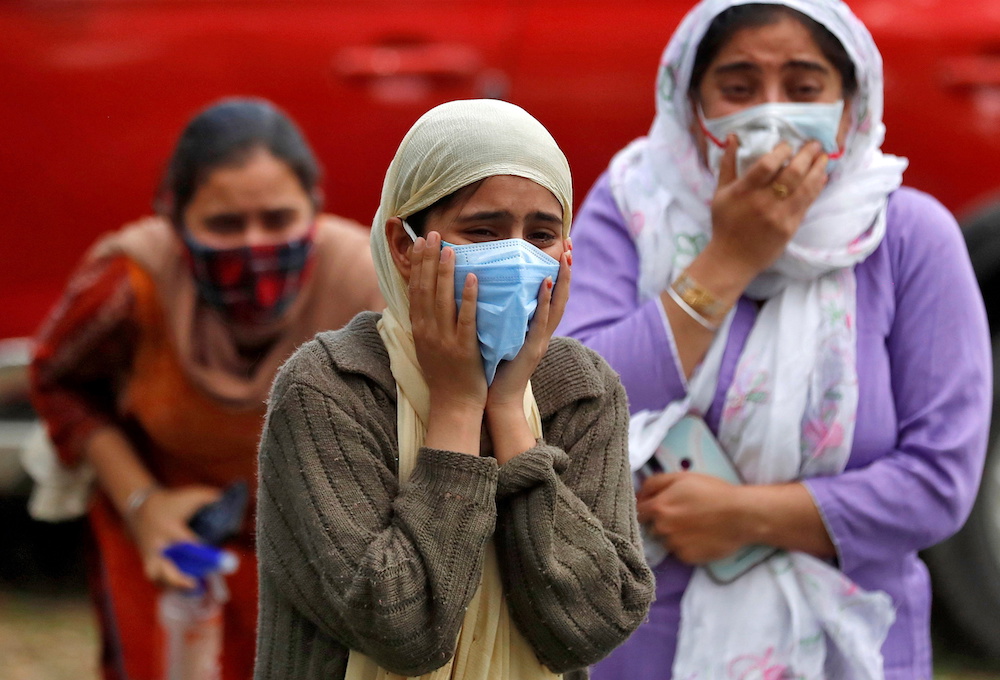NEW DELHI: New Delhi’s COVID-19 czar rejected on Friday a World Health Organization estimate that 4.7 million Indians — 10 times more than officially reported — lost their lives to the coronavirus disease.
The pandemic has devastated India, especially during the second viral wave between March and May 2021, as its hospitals ran out of staff, beds and oxygen. People with empty oxygen cylinders were seen lining up outside refilling facilities, hoping to save relatives in critical care in hospital.
Many were forced to turn to makeshift facilities for mass burials and cremations as funeral services could not deal with the unprecedented number of bodies.
The WHO said on Thursday that by the end of 2021 there were 14.9 million excess deaths globally associated with COVID-19.
The excess mortality figures reflect people who died of COVID-19 as well as those who died as an indirect result of the outbreak, including people who could not access healthcare for other conditions when hospitals were overwhelmed during huge waves of infection.
The WHO estimated that 4.7 million people died in India as a result of the pandemic, mainly during the second wave. Indian authorities, however, put the death toll for the period between January 2020 to December 2021 far lower — about 480,000.
Dr. N. K. Arora, chief of the Indian government’s COVID Working Group, told local media that the WHO’s findings were “preposterous,” adding: “This is very unfortunate that (the) WHO has done something of that kind.
“These are untenable figures.”
But to Indian citizens like Sunil Kumar Sinha, who lost his wife and 14 other family members during the second wave in Patna in the eastern state of Bihar, the fact that the UN body acknowledged his relatives were coronavirus victims has brought some relief.
“You have to acknowledge the death. Death has taken place, it’s a fact,” he told Arab News, adding that he was glad the WHO report was released.
“It was the worst time to witness. People died in large numbers due to oxygen shortage, lack of hospital beds. You cannot deny the report of the WHO. It’s truth. In 17 days, I lost 15 family members.”
Sinha was not surprised by the government’s refusal to accept the WHO data.
“The government doesn’t want to accept that there was oxygen shortage,” he said. “They don’t want to accept failure.”
Nitesh Mehta, a 16-year-old from Araria district in Bihar, lost both of his parents to the virus last year, but only his mother was counted as a COVID-19 victim.
For him, no report, local or international, could be of any consolation.
“No report can bring relief to the person who lost both his parents,” he said.
When the second coronavirus wave swept the country, Indian civil society was already on alert over the underreporting of casualties. In August 2021, a group of journalists from The Reporters’ Collective founded an online memorial project, the Wall of Grief, to make each coronavirus death count and document the pandemic’s hidden toll.
The Wall of Grief is a public depository with the names of coronavirus victims, their age, gender, occupation, place and date of death.
Relatives of a man who died from the coronavirus disease (COVID-19) mourn during his cremation at a crematorium ground in Srinagar May 25, 2021. (Reuters/File Photo)
It was supported by the independent news agency 101Reporters and the Delhi-based National Foundation for India, an independent organization for public welfare and social transformation.
“We have the names of people on the wall, so that people do not only become a number in this pandemic, so that their memory stays with us,” one of the project’s coordinators, Tapasya Tofuss, told Arab News.
She said the group’s data analysis supported the WHO’s findings. The Reporters’ Collective studied figures from four Indian states — Gujarat, Andhra Pradesh, Jharkhand and Rajasthan — where it found that excess deaths were from five to 27 times higher than officially reported.
“(The) WHO report is in line with excess death analysis that has been previously done, so it does not really seem as inflated as the government would call it,” Tofuss added.
According to her, one of the reasons of underreporting could be the matter of compensation, as the Supreme Court had ordered the federal government to pay 50,000 rupees ($650) to every family that lost a member to COVID-19.
“The government might be shirking the responsibility, accountability that comes with such huge numbers,” she said.
“With the Supreme Court order to compensate every COVID-19 victim, there is the financial burden of compensating so many people, because the excess death toll that we see is multiple times more than the officially recorded.”




